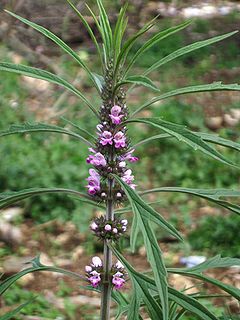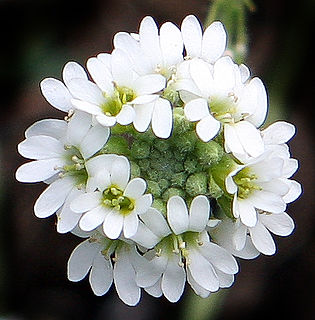
Ribes sanguineum, the flowering currant, redflower currant, red-flowering currant, or red currant is a North American species of flowering plant in the family Grossulariaceae, native to the western United States and Canada.

Artemisia californica, also known as California sagebrush, is a species of western North American shrub in the sunflower family.

Mammillaria dioica, also called the strawberry cactus, California fishhook cactus, strawberry pincushion or fishhook cactus, is a cactus species of the genus Mammillaria. Its common name in Spanish is biznaga llavina.

Aurinia saxatilis is an ornamental plant native to Asia and Europe.

Leonurus sibiricus, commonly called honeyweed or Siberian motherwort, is an herbaceous plant species native to China, Mongolia, and Siberia. It has verticillaster inflorescence. It is naturalized in many other parts of the world, including South, Central and North Americas.

Stellaria graminea is a species of flowering plant in the family Caryophyllaceae known by the common names common starwort, grass-leaved stitchwort, lesser stitchwort and grass-like starwort.

Alisma lanceolatum is a species of aquatic plant in the water plantain family known by the common names lanceleaf water plantain and narrow-leaved water plantain. It is widespread across Europe, North Africa and temperate Asia. It is naturalized in Australia, New Zealand, Oregon, California and British Columbia. It is considered a noxious weed in some places.

Berteroa incana is a species of flowering plant in the mustard family, Brassicaceae. Its common names include hoary alyssum, false hoary madwort, hoary berteroa, and hoary alison. It is a biennial herb native to Eurasia and it has been introduced to western Europe and North America. It is listed as an invasive noxious weed in some areas of United States and Canada

Alyssum alyssoides is a species of flowering plant in the mustard family known by several common names, including pale madwort and yellow alyssum. It is native to Eurasia, but it can be found throughout much of the temperate world as an introduced species and sometimes a common weed. For example, it has been noted as a weed in the western United States. It often appears in arable fields, sandy tracks, pits, and docks.

Artemisia nova is a North American species of sagebrush, known by the common name black sagebrush. It is "one of the most common shrubs in the western United States".

Balsamorhiza sagittata is a North American species of flowering plant in the sunflower tribe of the aster family known by the common name arrowleaf balsamroot. It is widespread across western Canada and much of the western United States. A specimen was collected by explorer and botanist Meriwether Lewis near Lewis and Clark Pass in 1806.

Liatris elegans, known commonly as pinkscale gayfeather, pinkscale blazingstar, and elegant blazingstar, is a species of flowering plant in the aster family, Asteraceae. It is native to the southeastern United States as far west as Texas and Oklahoma.

Pilostyles thurberi is a species of endoparasitic flowering plant known by the common names Thurber's stemsucker and Thurber's pilostyles. It is native to the southwestern United States and northern Mexico, where it grows in desert and woodland. In the United States, P. thurberi has been recorded from the states of Arizona, California, New Mexico, Nevada, Texas.

Cardamine angustata is a perennial forb native to the eastern United States, that produces white to pink or purple flowers in early spring.

Cardamine douglassii, the limestone bittercress or purple cress, is a perennial forb native to the eastern and central United States as well as the province of Ontario in Canada, that produces white to pink or purple flowers in early spring.

Clitoria mariana, is a perennial herbaceous plant.
Iris songarica is a beardless iris in the genus Iris, in the subgenus Limniris and in the series Tenuifoliae of the genus. It is a rhizomatous herbaceous perennial, from Central Asia, located in Afghanistan, Pakistan, Iran, Kazakhstan, Tajikistan, Turkmenistan and Uzbekistan. It has long strap-like leaves, a long stem and 2–3 flowers in shades of violet, dark blue, to lavender blue.
Iris psammocola is a plant species in the genus Iris, it is also in the subgenus Iris and in the section Pseudoregelia. It is a rhizomatous perennial, from China. It has grass-like leaves, short stems, yellow flowers. It is cultivated as an ornamental plant in temperate regions.

Pyrrocoma liatriformis is a species of flowering plant in the aster family. Its common names include Palouse goldenweed and smallhead goldenweed. It is native to the northwestern United States, where it is endemic to the Palouse prairie, growing in grassland dominated by blue bunchgrass. It is a perennial herb growing from a taproot, producing one to three stems up to 70 centimeters in length. The stems are erect and hairy. Leaves near the base of the plant are larger and rounder than the leaves connected to the stem, which are lanceolate and hairy. Basal leaves measure 80–310 millimeters long and 9–30 millimeters wide, whereas cauline leaves measure 30–120 millimeters long and 5–20 millimeters wide. The inflorescence is four to five heads arranged in a raceme. Each head is composed of 17–25 yellow ray florets, each 6–14.5 millimeters in length, as well as 35–60 disc florets, each 7–11 millimeters in length.

Alyssum montanum is a species of flowering plant belonging to the family Brassicaceae. It is an evergreen, prostrate perennial with small, hairy, greyish leaves. It typically grows to 10-15 centimeters tall and 30-45 centimeters across. It produces tiny, yellow, fragrant flowers from May to July. These flowers are typically 4-6 centimeters across and borne in dense racemes.


















